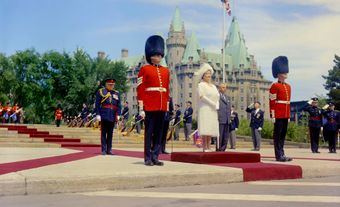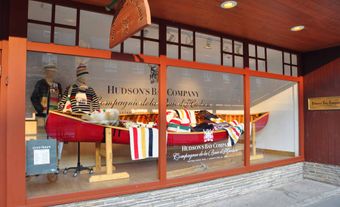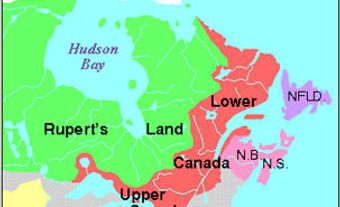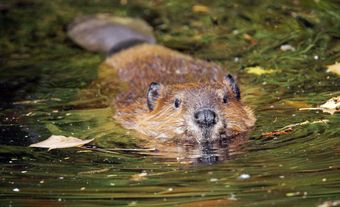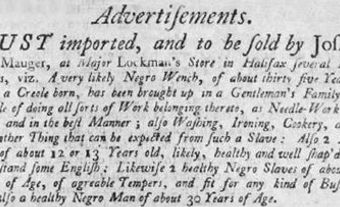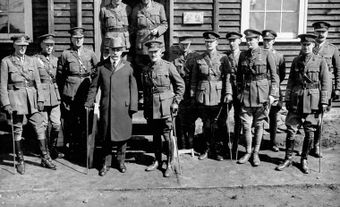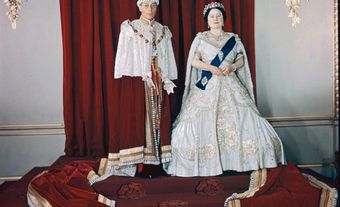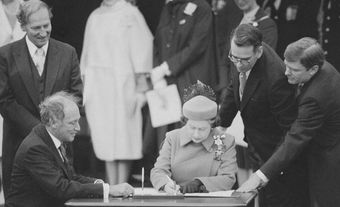Prince Rupert of the Rhine, Duke of Cumberland, military commander, privateer, administrator, artist, scientist, first governor of the Hudson’s Bay Company and founding member of the Royal African Company (born 17 December 1619 in Prague, Bohemia [now Czech Republic]; died 29 November 1682 in London, England [now United Kingdom]). A nephew of King Charles I of England, Scotland and Ireland, Rupert was a cavalry general and privateer during the English Civil Wars (1642–51). He was the first close relative of an English monarch to cross the Atlantic Ocean. Following the Restoration of the English monarchy in 1660, Rupert introduced Pierre-Esprit Radisson and Médard Chouart des Grosseilliers to his cousin King Charles II and persuaded the king to grant a royal charter to the Hudson’s Bay Company. Rupert’s Land and Prince Rupert, British Columbia, are named after Prince Rupert of the Rhine.

Early Life and Exile
Rupert was born in Prague, the fourth of 13 children of Frederick V, Elector Palatine of the Rhine in the Holy Roman Empire, and Elizabeth Stuart, the daughter of King James I of England (James VI of Scotland) and Anne of Denmark. In 1619, Frederick was elected king of Bohemia by the landowners representing the states of the Bohemian confederacy, who wanted a Protestant ruler instead of the Roman Catholic Holy Roman Emperor Ferdinand II. Three of the Holy Roman Emperor’s Catholic officials had been thrown out a window by Bohemian Protestants in 1618, an event known as the Defenestration of Prague. The Bohemian Revolt marked the beginning of the Thirty Years’ War (1618–48), which would shape the course of Rupert’s life.
Frederick V and Elizabeth became known as the “Winter King and Queen” because they held the Bohemian throne for only the single winter of Rupert’s birth. After Frederick V was defeated by Emperor Ferdinand II at the Battle of White Mountain in 1620, the family fled Prague so quickly that baby Rupert was almost left behind. Frederick V, Elizabeth and their children went into exile and settled in the Netherlands. Rupert and his siblings grew up at the Prisenhof in Leiden, where they were educated by scholars from nearby Leiden University. Rupert was a gifted student who excelled in languages, art, mathematics and science.

The Thirty Years’ War
Rupert joined the Dutch military at the age of 14 in an effort to help regain his family’s lands in the Rhine, which had been seized by the Holy Roman Emperor following the Battle of White Mountain. In 1638, Rupert was captured while commanding a Palatine cavalry regiment and was held prisoner in the Holy Roman Empire until 1641. He resisted efforts by Jesuit priests to convert him to Roman Catholicism.
The 1648 Treaty of Westphalia, which marked the end of the Thirty Years’ War, restored some of the Palatine lands in Germany to Rupert’s elder brother Charles Louis. Rupert and his other siblings, however, were not granted land and received little financial compensation at the end of the war. They had to seek their own fortunes elsewhere.
The English Civil Wars
Rupert first visited the court of his maternal uncle King Charles I of England, Scotland and Ireland in 1635. He was a popular figure because of his staunch Protestant faith and plain-spoken manner. When the English Civil Wars broke out between the king and parliament in 1642, Rupert and his younger brother Maurice became prominent commanders in the royalist army. Rupert achieved key victories at the Battle of Powick Bridge and the Battle of Edgehill but was criticized by supporters of parliament for introducing the brutal tactics of The Thirty Years’ War into the conflict, including pillaging towns that refused to surrender. Accounts of Rupert’s tactics as a royalist commander introduced the German word plunder to the English language.

The Royalist Navy
Following a decisive royalist defeat at the Battle of Naseby in 1645, Rupert was banished from England. Charles I was placed on trial by parliament and executed in 1649. During the interregnum, when England was a republic without a monarch, Rupert worked on behalf of his cousin, the future King Charles II. As a privateer captain in the royalist navy, Rupert became the first close relative of an English monarch to cross the Atlantic Ocean. Rupert and his younger brother Maurice were at sea from 1650 to 1653, first sailing to Lisbon to seek Portuguese support for the royalist cause and then to Madeira, the Azores and the west coast of Africa. Rupert was interested in reports of gold along the Gambia River and sailed 150 miles inland — activities that would inform his later involvement in the Royal Africa Company.
In 1652, the royalist fleet crossed the Atlantic, visiting Montserrat, Saint Kitts and Saint Lucia, and seized Spanish and English Protectorate ships containing gold and valuable trade goods, such as sugar. The royalist navy was struck by a hurricane in September 1652, resulting in the loss of the flagship Constant Reformation, 333 sailors (including Maurice) and much of the wealth seized from Spanish and English ships. Rupert returned to Europe in 1653 and became a mercenary.
The Restoration Court
In 1660, the monarchy was restored in England, and Rupert’s cousin King Charles II became king. Rupert held the titles of Duke of Cumberland and Earl of Holderness and was a prominent figure at Charles II’s court. However, he had little independent income and was always interested in new business opportunities. In 1668, Charles II appointed Rupert to the post of Constable of Windsor Castle, where he maintained a suite of rooms and undertook repairs and renovations, such as the reconstruction of the tennis court and the repair of the Devil’s Tower.
Art and Science
Rupert was an enthusiastic amateur scientist and became an honourary member of the Royal Society. His signature appears on the first page of the Royal Society’s Charter Book. He introduced new military technologies to Britain, including new forms of gunpowder and grapeshot, and an early type of machine gun. He invented a diving engine for retrieving objects from the ocean floor and presented papers to the Royal Society about the treatment of war wounds, including severe burns. In 1661, Rupert presented five tadpole-shaped pieces of glass that could withstand hammer blows but would shatter into a fine powder when their tails were clipped. These structures became known as “Prince Rupert’s drops.” As an artist, Rupert pioneered new techniques in mezzotint, inventing the rocker used to roughen the printing plate to achieve a rich, velvety tone. His most famous piece is The Great Executioner with the Head of Saint John the Baptist (1658).

The Royal African Company
Rupert had travelled up the Gambia River with the royalist navy in 1652 and remained interested in finding gold there after the Restoration. In 1660, King Charles II granted a charter to the Company of Royal Adventurers Trading to Africa, providing a monopoly over English trade with Africa. Rupert was the first governor of the Royal African Company and one of the principal investors. In the original charter, the company’s principal objective was the search for gold along the Gambia River, but a new charter issued in 1663 gave the company a monopoly over the British trade in enslaved Africans. The original company collapsed in 1667 following financial losses and was succeeded by the new Royal African Company in 1672. Rupert was a member of this company’s board, and his cousin, the Duke of York (the future King James II), served as governor. Between 1662 and 1731, the Company transported approximately 212,000 enslaved people from Africa to the Americas, 44,000 of whom died during these voyages. (See also Black Enslavement in Canada.)
The Hudson’s Bay Company
In 1665, Rupert met with Pierre-Esprit Radisson and Médard Chouart des Grosseilliers and learned about their journeys to Hudson Bay. He introduced them to his cousin Charles II. Charles II was initially reluctant to finance their future voyages as he was concerned about conflict with another one of his royal cousins, King Louis XIV of France. Rupert organized a group of private investors to finance an expedition. Rupert and his fellow investors were rowed up the River Thames to bid farewell to Radisson and Des Groseilliers when their two ships left London on 3 June 1668. The return of the expedition in August of 1669 demonstrated that it was possible for English ships to sail across the Atlantic Ocean to Hudson Bay, trade with Indigenous peoples over the winter and return with a cargo of beaver pelts the next year. (See Fur Trade in Canada.) Beaver pelts were a lucrative trade good essential to the production of fashionable beaver pelt hats.
On 2 May 1670, King Charles II granted the Royal Charter to “the Governor and Company of Adventurers of England trading into Hudson’s Bay.” Charles II appointed Rupert, “Our Dear and Entirely Beloved Cousin,” first governor of the Hudson’s Bay Company. According to the royal charter, the new company owned the entire Hudson Bay watershed and held a monopoly on all trade there. This land grant, which comprised nearly 40 per cent of modern-day Canada, was known as “ Rupert’s Land.” Rupert held the role of governor until his death in 1682.
Children
Rupert never married, but he had a long-term relationship with actress Margaret Hughes for the last 14 years of his life. They had a daughter, Ruperta (1671–1741), who married Lieutenant-General Emanuel Scrope Howe and had six children of her own. Rupert also had a son, Dudley Bard, (1666–86), who became a military officer and died in battle at the age of twenty.
Death and Legacy
The city of Prince Rupert in British Columbia, the Prince Rupert neighbourhood in northwest Edmonton, and Quebec’s Rupert River, which drains into Rupert Bay on James Bay, are named for Rupert. The Hudson’s Bay Company remains the oldest incorporated joint-stock merchandising company in the English-speaking world. Rupert has received critical scrutiny in recent years because of the role of his business interests in the Hudson’s Bay Company and the Royal African Company in the expansion of the British Empire, colonialism and the trans-Atlantic slave trade.
The current sovereign of the United Kingdom, Canada and 13 other Commonwealth realms, King Charles III, is a descendant of Rupert’s youngest sister, Sophia of Hanover, whose eldest son became King George I in 1714.

 Share on Facebook
Share on Facebook Share on X
Share on X Share by Email
Share by Email Share on Google Classroom
Share on Google Classroom
